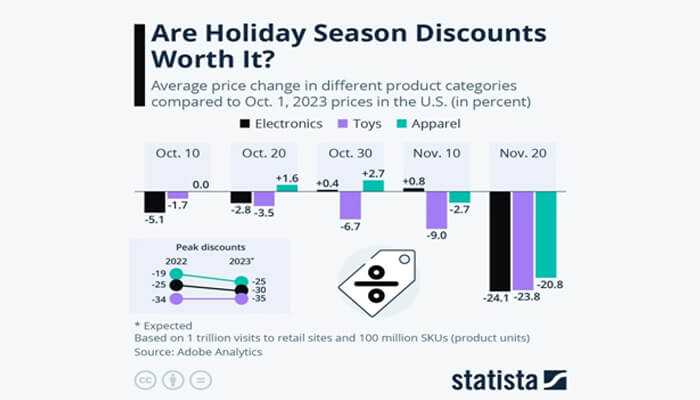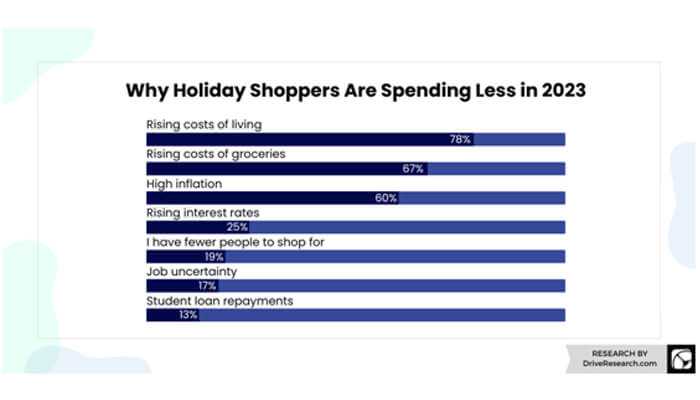Imagine a day when shopping deals flood the internet and stores alike, marking a significant spike in sales. This is Black Friday, a phenomenon that, although rooted in the United States, has a growing impact globally.
In the U.S., Black Friday, which falls on the Friday following Thanksgiving, traditionally marks the start of the Christmas shopping season. In India, it’s become the unofficial kickoff to the holiday shopping spree.
Black Friday retail sales in the United States have seen an impressive rise this year. The sales on Friday, November 24, witnessed a 2.5 percent increase compared to last year. The term ‘Black Friday’ only gained widespread recognition in the late 1980s, symbolizing the transition from financial loss (often denoted as red) to profit (‘black’) for retailers.
In this article, let’s look into the economic impact of Black Friday and examine its influence on consumer habits and retail tactics.
The Economics Behind the Black Friday Sale
Black Friday has evolved into a major global shopping phenomenon, recording a remarkable $9.8 billion in online sales. This marked a 7.5% surge over the sales figures of the prior year. The rise in consumer spending extended beyond the U.S., reflecting a worldwide trend.
In India, Black Friday is rapidly gaining momentum. Forecasts suggest an impressive annual growth rate of 37.4% by 2032.
How Stores Actually Make Money
Black Friday acts as a self-selection mechanism. This is a process where individuals or groups naturally sort themselves into different categories based on their preferences, behaviors, or characteristics.
In the context of Black Friday, this concept refers to how different types of shoppers are drawn to the event for various reasons. For example, some shoppers might be motivated by big discounts on luxury items, while others might focus on finding deals on everyday necessities.
Sales Velocity
In 2022, Amazon.co.uk witnessed a 74% increase in sales during Black Friday and Cyber Monday, largely attributed to the impact of sponsored ads. The concept of sales velocity plays an essential role here.
This metric is calculated using algorithms and includes several factors:
- The demand for a product
- The speed at which it sells, and
- The ratio of purchases to views
For instance, a product that is frequently viewed but seldom bought would have a lower sales velocity compared to one that is both highly viewed and purchased often.
Similarly, products with higher sales velocities are ranked higher in search results, making them more visible to potential buyers. This is especially important during peak shopping events like Black Friday or Cyber Monday.
For example, a toy that becomes a bestseller during the holiday season may continue to appear higher in search results even after the holidays, due to its high sales velocity achieved during these peak times.
This enhanced visibility can lead to sustained increased sales even on regular days, benefiting the seller in the long term.
List Building
Black Friday sales often involve email marketing strategies. Customers may need to provide their email to receive a discount code or simply when checking out. These email and Facebook Messenger lists are invaluable for future marketing efforts.
Volume
By offering lower prices, retailers see a significant increase in order volumes. While the margins on each sale might be lower, the overall amount from these sales is higher.
This strategy is particularly beneficial for sellers looking to boost their sales figures quickly or those planning to sell their company.
Inventory Management
Retailers often use Black Friday to clear out inventory, especially items close to their expiration date or seasonal products.
Selling items on Black Friday has two main benefits.
1. First, it creates immediate cash flow. This cash can be used for future seasons or to develop new products.
2. Second, it helps avoid long-term warehousing costs. This is particularly important in countries where the retailer does not own their storage facilities.
These strategies collectively enable stores to capitalize on Black Friday, turning it into a day of lucrative sales and significant business growth.
Stock Performance During Black Friday
It is on the Wednesday before Thanksgiving that stock performance starts showing a boost. In the five-year period from 2018 to 2022, the S&P 500 went up by nearly 52%.
This growth tells us two important things. First, when the U.S. stock market does well, it catches the attention of investors around the world. Second, these investors might start looking at Indian stocks. This could lead to more foreign investment in India’s stock market. This is a good example of how changes in one country’s market can affect markets in other countries.
The chart below showcases the average price change in various product categories compared to their prices on October 1, 2023, in the U.S. This data reflects how Black Friday impacts not just the stock market but also consumer goods prices across different sectors.
Benefits
Black Friday is a significant event that positively impacts the economy. It’s a time when businesses see a surge in sales, more jobs are created, and consumer demand skyrockets. These benefits are crucial for both the economy and individuals.
Let’s look at each of these benefits in detail.
Job Creation
Among these, job creation stands out prominently. Retailers usually hire more staff to handle the large number of customers during Black Friday, both in their physical stores and online. This increase in temporary jobs is good for people looking for work and also helps the economy.
Sales
In terms of sales, Black Friday dramatically boosts consumer spending. Categories like clothing and accessories, which see 82% of purchases, and electronics, at 73%, dominate the Black Friday sales.
Increased Demand
Discounts and deals drive a significant volume of transactions in these sectors. Interestingly, the trend of beginning Black Friday shopping on Thanksgiving is on the rise, with 35% of consumers expected to start their shopping spree on Thanksgiving 2023—a 13% increase from 2022.
Pitfalls to Avoid
While Black Friday offers many benefits, it also comes with potential pitfalls, particularly for consumers.
Impulsive buying is a common issue during this period. The allure of ‘once-a-year’ deals can lead to unplanned purchases and strain personal finances.
For example, you might find yourself purchasing a high-end electronic gadget you didn’t plan to buy simply because the discount seems too good to pass up. However, later on, you might realize that this purchase was an unnecessary expenditure.
Furthermore, the current economic climate adds another layer of caution. With the rising cost of living, increasing grocery prices, and high inflation, people are becoming more conservative with their holiday spending in 2023. These financial pressures make it more important than ever for consumers to shop wisely.
Over-reliance on credit, lured by easy access and the promise of dealing with payments later, can lead to a debt trap. Shoppers must balance the excitement of finding a good deal with the reality of their financial situation, avoiding spending beyond their means.
For investors and business owners, understanding these is key to navigating the Black Friday season effectively, balancing the drive for profit with responsible marketing and sales practices.
Black Friday in the Digital Age
Black Friday has evolved significantly in the digital era, transforming the way consumers and brands interact.
The concept of the fear of missing out (F.O.M.O.) plays a substantial role. Worried about missing out on good deals, consumers often buy things quickly without much thought. In fact, a study revealed that individuals tend to show aggressive behavior during sales, especially if they perceive a threat to acquiring their desired product.
Digital platforms also allow for personalized marketing tactics. In 2022, an interesting trend was observed in online sales: desktops, with a 5.6% conversion rate, outperformed mobile devices, which had a 3.3% conversion rate. This data is invaluable for brands in tailoring their digital strategies for maximum impact and sales conversion.
Final Thoughts
Black Friday presents both challenges and opportunities. Whether you are a consumer trying to snag the best deals or a brand aiming to boost sales while maintaining a positive image, understanding the nuances of this shopping phenomenon is crucial.
In the midst of events like Black Friday, where spending can often overshadow saving, consider a different approach. Instead of getting swept up in the spending spree, why not explore smart investment options? This is where appreciation comes in. It is an online trading platform where you get to understand not just the value of saving but also the power of investing wisely.
Author Bio :
Yogesh is a co-founder at Appreciate, a fintech platform helping Indians achieve their financial goals through globally diversified one-click investing.





